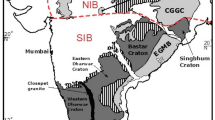Abstract
Stratigraphic correlations and tectonic analysis suggest that the Puncoviscana fold belt of northwestern Argentina was an intracontinental basin with bimodal igneous suites that formed in connection with the breakup of the Rodinia supercontinent (at ∼800 Ma). Several lines of evidences point to an initial lithosphere rupture, possibly induced by a rising mantle plume. The earliest synrift igneous products are represented by ultra-potassic dykes and alkaline lava flows of high LREE/HREE and low Zr/Nb–Y/Nb ratios. The dyke emplacements and the initiation of rifting were probably synchronous. They pass laterally and upwards (middle part of the Puncoviscana succession) into basalts of alkaline transitional character (OIB-like source). The distinctive chemical feature of these lavas are very similar to the source of oceanic island basalts; thus, they are thought to represent a magmatism associated with the rift and rift-drift transition stage. During this stage of rifting probably true oceanic crust was formed. The upper part of the Puncoviscana sequence, Late Precambrian/Lower Cambrian in age, comprises a thick and monotonous sequence of pillow lavas, massive basaltic flows and minor volcanic breccias and hyaloclastites. These lavas exhibit MORB trace element characteristics with high FeOt and TiO2, low K2O and P2O5, flat light REE spectra, little or no depletion in Nb and Ta. This volcanism consists of the major and latest effusive episode from the Puncoviscana basin which was slightly modified by subduction processes. The geodynamical model proposed for the generation of these volcanic rocks could have been developed in two stages. In the first stage the volcanic event is compatible with a progressive opening of a continental rift leading to formation of a mature oceanic basin. In contrast, the second stage shows the effects of a completed Wilson cycle including a primitive volcanic arc which continued until the accreted Cuyania-Arequipa-Belen-Antofalla (CABA) terrane against the proto-Gondwana western borderland of the Amazonian shield (∼535 Ma).
Similar content being viewed by others
Author information
Authors and Affiliations
Additional information
Received: 23 December 1997 / Accepted: 9 December 1998
Rights and permissions
About this article
Cite this article
Omarini, R., Sureda, R., Götze, HJ. et al. Puncoviscana folded belt in northwestern Argentina: testimony of Late Proterozoic Rodinia fragmentation and pre-Gondwana collisional episodes. Int Journ Earth Sciences 88, 76–97 (1999). https://doi.org/10.1007/s005310050247
Issue Date:
DOI: https://doi.org/10.1007/s005310050247




